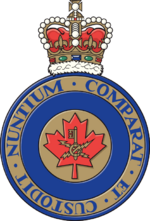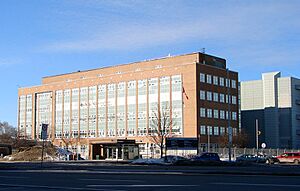Communications Security Establishment facts for kids
The Communications Security Establishment (CSE) is Canada's national agency for code-breaking and security. It helps protect Canada by gathering foreign signals intelligence, doing cyber operations, and keeping computer systems safe. CSE also helps the Canadian military, police, and other security groups.
CSE is a separate agency that works under the National Defence department. The current head of CSE is Caroline Xavier, who started her role on August 31, 2022. She reports to the Minister of National Defence, who then reports to the Canadian government and Parliament.

Badge of CSE
|
|

CSE wordmark
|
|
 Edward Drake Building, CSE headquarters |
|
| Agency overview | |
|---|---|
| Formed | 1946 |
| Preceding agency |
|
| Type | government agency responsible for
|
| Headquarters | Ottawa, Ontario, Canada |
| Employees | 3,841 (2024-25) |
| Annual budget | $1,041.7 million (2024–25) |
| Minister responsible |
|
| Agency executive |
|
| Child agencies |
|
| Key document |
|
Contents
History of CSE
CSE's story began during the Second World War. At that time, Canada had groups working to break secret codes and gather intelligence.
The Examination Unit
The Examination Unit (XU) was created in June 1941. It was part of the National Research Council. In March 1942, XU moved to Laurier House in Ottawa. This location was chosen to avoid drawing attention from enemies.
The XU's first job during World War II was to intercept messages from Vichy France and Nazi Germany. Later, it also started intercepting and decoding messages from Japan. About 50 people worked there at any one time.
After the war, leaders in the United States and Canada decided that this kind of work was still important. So, on April 13, 1946, a secret order created the Communications Branch of the National Research Council of Canada (CBNRC). This agency was the start of today's CSE.
Communications Branch of the National Research Council
The Communications Branch of the National Research Council (CBNRC) was Canada's first secret code-breaking agency during peacetime. It was formed by combining the civilian Examination Unit and a military unit. The CBNRC was located at LaSalle Academy.
Edward Drake was the first director of the CBNRC. The agency worked with intercepted foreign electronic messages. These messages were mostly collected from a station at Rockcliffe Airport and Canadian Forces Station Leitrim (CFS Leitrim). CFS Leitrim is Canada's oldest signal intelligence station, started in 1941. The CBNRC successfully decoded, translated, and analyzed these signals. They turned this raw information into useful intelligence reports.
The CBNRC also began working on keeping Canadian communications safe starting January 1, 1947. During the Cold War, the CBNRC mainly provided secret information to the Department of National Defence about the military operations of the Soviet Union.
The CBNRC and its work were kept secret for 34 years. On January 9, 1974, a TV show called The Fifth Estate revealed the organization. This led to public discussion and the Canadian government admitting the agency existed.
Communications Security Establishment
In 1975, the CBNRC was moved to the Department of National Defence (DND). It was then renamed the Communications Security Establishment (CSE). By this time, CSE was publicly known and had grown to become Canada's main source of SIGINT.
In 1988, CSE created the Canadian System Security Centre. This center aimed to set a standard for computer security in Canada. After the September 11 attacks in 2001, Canada passed the Anti-terrorism Act. This law officially recognized and gave power to CSE's activities.
In 2008, CSE started using the name Communications Security Establishment Canada (CSEC) to follow government rules. However, since mid-2014, the organization has gone back to using its original legal name, Communications Security Establishment (CSE). In November 2011, CSE became an independent agency.
In June 2019, the Communications Security Establishment Act became law. This act clearly defined CSE's job and powers. It also created the National Security and Intelligence Review Agency (NSIRA) to oversee CSE's activities. In August 2021, CSE helped with the operation to airlift Canadians out of Kabul after the Taliban took over Afghanistan.
What CSE Does
CSE is unique in Canada's security and intelligence community. It employs experts who create and break codes (cryptanalysis). They provide the Canadian government with information technology security and foreign signals intelligence. CSE also helps the Royal Canadian Mounted Police and other federal law enforcement and security agencies.
Foreign Signals Intelligence
CSE works closely with its allies: the US, UK, Australia, and New Zealand. They share the work of collecting information and the intelligence they find. Canada benefits greatly from this teamwork in gathering and reporting on foreign communications.
During the Cold War, CSE's main focus was providing information about the military operations of the Soviet Union to National Defence. Since the Cold War ended, the Canadian government's needs have changed. Now, CSE also focuses on political, defence, and security issues for many different government departments. There is also a growing focus on protecting Canadians from global issues like terrorism.
Code-breaking equipment
CSE's ability to break codes improved a lot in the 1980s. They bought a powerful Cray X-MP/11 supercomputer in March 1985. This was the most powerful computer in Canada at the time. In the early 1990s, they bought another supercomputer. These older machines are no longer used. Little public information is available about the types of computers CSE uses today.
Cyber Operations
CSE is allowed to conduct foreign cyber operations to stop enemies and protect Canada and Canadians. These cyber operations can be defensive or active. They must be related to international affairs, defence, or security.
Defensive cyber operations mean CSE can protect Canadian systems from foreign cyber attacks. For example, if someone tries to steal information from a government computer network, CSE could stop them by disabling their server. CSE can also protect important systems like energy grids, telecom networks, and banking systems if the Minister of National Defence approves it.
Active cyber operations allow CSE to take action against threats to Canada. These threats include terrorist groups, cyber criminals, and hostile intelligence agencies. For example, CSE can disrupt an enemy's way of communicating.
Helping Federal Partners
CSE can provide technical and operational help to other federal partners. This includes the military, law enforcement, and other intelligence agencies. This help can involve collecting communications, providing technical solutions, language support, and conducting operations.
When CSE helps another agency, it must follow that agency's legal rules. This means CSE can sometimes target Canadians or people in Canada if the requesting agency has the legal right to do so, like with a court order.
Canadian Centre for Cyber Security
The Canadian Centre for Cyber Security (CCCS or Cyber Centre) is the Canadian government's main authority for cyber security. It watches for threats, protects important national computer systems, and helps coordinate Canada's response to cyber incidents.
The Cyber Centre is part of CSE. It acts as Canada's computer emergency response team (CSIRT) and the government's incident response team (CIRT). It was officially created on October 1, 2018. The CCCS brought together existing cyber-security units from different government organizations.
History of the Cyber Centre
CSE's Information Technology Security branch, which became part of the Cyber Centre, grew from the need to protect sensitive government information. The Cyber Centre was developed after CSE talked with Canadians in 2016. These discussions showed issues with government cyber security, like who was in charge and how departments worked together.
In February 2018, the federal budget provided money for CSE to launch the Cyber Centre. It officially opened on October 1, 2018. In 2024-25, the Cyber Centre's systems reportedly defended against 2.3 trillion harmful actions. This is about 6.3 billion actions every day.
Vulnerability Research Centre
| Centre de Recherche sur les Vulnérabilités | |
 |
|
| Type | research division |
|---|---|
| Parent department | Communications Security Establishment |
The Vulnerability Research Centre (VRC) is part of CSE's Research team. Its main goal is to improve Canada's security through top-level research into computer weaknesses. The VRC does this by:
- Checking important government systems for security flaws.
- Researching computer security weaknesses by looking at code and analyzing software.
- Giving advice on how to prevent and fix weaknesses.
- Developing new ways to find security weaknesses.
- Working with other government departments and international partners.
- Training new experts in vulnerability research.
The VRC also works with universities like the University of Toronto and Concordia University.
Tutte Institute for Mathematics and Computing
 |
|
| Institute overview | |
|---|---|
| Formed | 2011 |
| Type | research institute |
| Jurisdiction | Canada |
| Headquarters | Edward Drake Building, Ottawa, ON |
| Institute executive |
|
| Parent department | Communications Security Establishment |
The Tutte Institute for Mathematics and Computing (TIMC) is a research program of the Canadian government. It conducts both secret and public research in cryptology (the study of codes) and knowledge discovery. This research supports Canada's code-breaking efforts and its international partners.
TIMC officially opened in September 2011. It is named after the famous code-breaker and mathematician William T. Tutte. TIMC is located inside CSE's Edward Drake Building in Ottawa.
CSE sponsors and funds the institute. TIMC works with other research institutes and universities. Researchers from CSE proposed and created the institute.
Public Contributions
Researchers at the Tutte Institute developed a technique called Uniform Manifold Approximation and Projection (UMAP). It was first designed to analyze harmful software. TIMC later released UMAP to the public. It is now used to help answer questions about COVID-19.
As of 2024-25, TIMC's public contributions have been downloaded over 2.5 million times each month.
Facilities
CSE has several buildings in Ottawa. These include the Edward Drake Building and the Cyber Centre's office at 1625 Vanier Parkway. CSE used to be in the Sir Leonard Tilley Building.
Because CSE grew quickly after the 9/11 attack, new facilities were built. A new CA$1.2 billion building, covering 72,000 square meters, was built in eastern Ottawa. Construction started in early 2011 and finished in 2015.
On February 26, 2015, CSE officially opened its headquarters at the new Edward Drake Building. It is named after Lt. Colonel Edward Drake, a pioneer in Canadian signals intelligence.
With the launch of the Canadian Centre for Cyber Security in 2018, CSE needed more space. So, they expanded into a second location. This building also houses the Learning Hub, which trains government employees in cyber security.
CSE used to be in the Tilley Building, starting in June 1961. This building was named after Samuel Leonard Tilley, a former Canadian Finance Minister.
Insignia
CSE uses standard government identifiers. However, CSE is one of the few federal agencies that has its own badge. The badge was given in 1994. CSE's pennant was first raised in 1996 to celebrate the organization's 50th anniversary.
From the 1990s to the mid-2000s, CSE's Information Technology Security program used a special logo. The triangle in the logo stood for threats, and the arc symbolized protection.
How CSE is Managed
Laws Guiding CSE
CSE must follow all Canadian laws. These include the Criminal Code, the Canadian Charter of Rights and Freedoms, and the Privacy Act.
In December 2001, the Canadian government passed the Anti-terrorism Act. This law changed parts of the National Defence Act and officially recognized CSE's role. It also gave CSE more power to fight terrorism.
| Communications Security Establishment Act | |
|---|---|
 |
|
| Parliament of Canada | |
| An Act to establish the Communications Security Establishment | |
| Citation | S.C. 2019, c. 13, s. 76 |
| Enacted by | section 76 of chapter 13 of the Statutes of Canada, 2019 |
| Date assented to | 21 June 2019 |
| Date effective | 1 August 2019 |
| Status: Current legislation | |
Communications Security Establishment Act
In June 2019, the Communications Security Establishment Act (CSE Act) became law. This act states that CSE cannot target Canadians anywhere in the world, or anyone in Canada. This is unless there is a serious and immediate danger to life or safety. The Act also requires CSE to protect the privacy of Canadians. By law, CSE cannot intercept messages within Canada. If a message is between a Canadian and a foreign source, the Canadian part of the message is usually deleted or ignored. However, after the September 11 attacks in 2001, CSE's powers expanded. It can now intercept foreign messages that start or end in Canada, if the other person is outside Canada and a special authorization is given.
Management and Oversight
The Minister of National Defence guides CSE's activities. The Minister uses directives and orders based on the government's intelligence priorities. The Minister cannot allow CSE to do anything outside its legal powers.
CSE is overseen by independent groups:
- National Security and Intelligence Review Agency (NSIRA) – NSIRA is fully independent. Its members are chosen by the Prime Minister. It handles complaints against all Canadian national security agencies.
- Intelligence Commissioner – This Commissioner is independent of CSE. They oversee all national security and intelligence activities of the Canadian government, including CSE. The Commissioner reports to the Prime Minister each year.
- National Security and Intelligence Committee of Parliamentarians (NSICOP) – This committee is made up of Members of Parliament. They have the security clearances to review any part of CSE's work.
CSE's activities are also reviewed by other federal bodies. These include the Privacy Commissioner and the Auditor General.
Heads of CSE
| Name | Appointed | Notes |
|---|---|---|
| Examination Unit | ||
| Herbert Yardley | 1941 June 10 | |
| Oliver Strachey | 1942 January | |
| F.A. (Tony) Kendrick | 1942 July | |
| Gilbert de B. Robinson (acting) | 1945 April | until July 1945 |
| Edward Drake | 1945 August 1 | |
| Communications Branch of the National Research Council | ||
| Edward Drake | 1946 September 1 | died in office |
| Kevin O’Neill | 1971 February | |
| Communications Security Establishment | ||
| Peter Hunt | 1980 July | |
| Stewart Woolner | 1989 July | |
| Ian Glen | 1999 July | |
| Keith Coulter | 2001 August | |
| John Adams | 2005 July | |
| John Forster | 2012 January 30 | |
| Greta Bossenmaier | 2015 February 9 | |
| Shelly Bruce | 2018 June 27 | |
| Caroline Xavier | 2022 August 31 | |
Former Oversight: CSE Commissioner
Oversight of CSE used to be handled by the Office of the Communications Security Establishment Commissioner (OCSEC). This office was created on June 19, 1996. Its job was to check if CSE's activities followed the law. It also investigated complaints about the agency's actions. The Commissioner provided a public report to Parliament each year.
Between 1996 and 2019, there were six Commissioners. In 2019, as part of a new national security law, the OCSEC was closed. Its responsibilities were divided between two new groups: the Office of the Intelligence Commissioner and the National Security and Intelligence Review Agency (NSIRA).
ECHELON
Under a 1948 agreement called UKUSA, CSE shares its intelligence with other countries. These include the U.S. National Security Agency (NSA), the British Government Communications Headquarters (GCHQ), the Australian Signals Directorate (ASD), and New Zealand's Government Communications Security Bureau (GCSB).
Along with these agencies, CSE is believed to be part of a system called ECHELON. This system is thought to be able to monitor a large amount of the world's phone calls, faxes, and data traffic.
See also
- Badge of the Communications Security Establishment
- Canadian Security Intelligence Service (CSIS)
- Cray
- ECHELON
- Royal Canadian Mounted Police (RCMP)
- Security clearances
- Security of Information Act
- Treasury Board
- List of intelligence agencies
- FAPSI (Russia)
- GCHQ (UK)
- National Security Agency (US)
External links
pt:CSE






